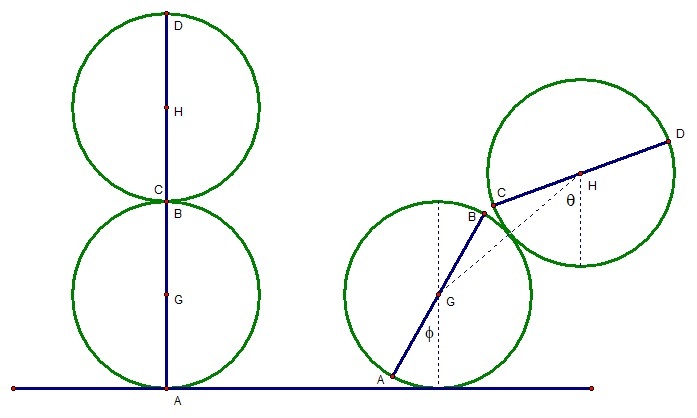Two solid cylinders
A solid cylinder of radius rests on another identical cylinder that rests on the floor in an unstable equilibrium.
If the system is slightly disrupted and there's no sliding between any surfaces, with the cylinders maintaining contact, the angle that the line joining the centers make with the vertical satisfies where is the acceleration due to gravity and are positive integers such that the fraction is irreducible.
What is
The answer is 37.
This section requires Javascript.
You are seeing this because something didn't load right. We suggest you, (a) try
refreshing the page, (b) enabling javascript if it is disabled on your browser and,
finally, (c)
loading the
non-javascript version of this page
. We're sorry about the hassle.
I found it easier to determine the rolling conditions when I changed the sign of φ , so I have redrawn the diagram to suit. The position vector of the centre of mass
G
of the bottom cylinder is
O
G
=
(
R
φ
R
)
The position vector of the centre of mass
H
of the top cylinder is
O
H
=
(
R
φ
+
2
R
sin
θ
R
+
2
R
cos
θ
)
(this ensures that there is no slipping) which means that the two centres of mass have velocities
v
G
=
(
R
φ
˙
0
)
v
H
=
(
R
φ
˙
+
2
R
cos
θ
θ
˙
−
2
R
sin
θ
θ
˙
)
In addition, the bottom and top cylinders have angular velocities
φ
˙
and
2
θ
˙
−
φ
˙
respectively. Thus the kinetic energy of the system is
T
=
2
1
M
(
R
φ
˙
)
2
+
4
1
M
R
2
φ
˙
2
+
2
1
M
R
2
[
(
φ
˙
+
2
cos
θ
θ
˙
)
2
+
4
sin
2
θ
θ
˙
2
]
+
4
1
M
R
2
(
2
θ
˙
−
φ
˙
)
2
=
2
1
M
R
2
[
3
φ
˙
2
+
6
θ
˙
2
+
2
(
2
cos
θ
−
1
)
φ
˙
θ
˙
]
and so the Lagrangian of the system is
L
=
T
−
2
M
g
R
cos
θ
. Since
L
is independent of
φ
, it follows that
∂
φ
˙
∂
L
is a constant of the motion, and hence we deduce that
3
φ
˙
+
2
(
2
cos
θ
−
1
)
θ
˙
=
0
Conservation of energy now tells us that
2
1
M
R
2
[
3
φ
˙
2
+
6
θ
˙
2
+
2
(
2
cos
θ
−
1
)
φ
˙
θ
˙
]
+
2
M
g
R
cos
θ
=
2
M
g
R
Substituting
φ
˙
=
−
3
2
(
2
cos
θ
−
1
)
θ
˙
into this equation yields the formula
θ
˙
2
=
R
(
1
7
+
4
cos
θ
−
4
cos
2
θ
)
1
2
g
(
1
−
cos
θ
)
making the answer
1
2
+
1
7
+
4
+
4
=
3
7
.
The position vector of the centre of mass
G
of the bottom cylinder is
O
G
=
(
R
φ
R
)
The position vector of the centre of mass
H
of the top cylinder is
O
H
=
(
R
φ
+
2
R
sin
θ
R
+
2
R
cos
θ
)
(this ensures that there is no slipping) which means that the two centres of mass have velocities
v
G
=
(
R
φ
˙
0
)
v
H
=
(
R
φ
˙
+
2
R
cos
θ
θ
˙
−
2
R
sin
θ
θ
˙
)
In addition, the bottom and top cylinders have angular velocities
φ
˙
and
2
θ
˙
−
φ
˙
respectively. Thus the kinetic energy of the system is
T
=
2
1
M
(
R
φ
˙
)
2
+
4
1
M
R
2
φ
˙
2
+
2
1
M
R
2
[
(
φ
˙
+
2
cos
θ
θ
˙
)
2
+
4
sin
2
θ
θ
˙
2
]
+
4
1
M
R
2
(
2
θ
˙
−
φ
˙
)
2
=
2
1
M
R
2
[
3
φ
˙
2
+
6
θ
˙
2
+
2
(
2
cos
θ
−
1
)
φ
˙
θ
˙
]
and so the Lagrangian of the system is
L
=
T
−
2
M
g
R
cos
θ
. Since
L
is independent of
φ
, it follows that
∂
φ
˙
∂
L
is a constant of the motion, and hence we deduce that
3
φ
˙
+
2
(
2
cos
θ
−
1
)
θ
˙
=
0
Conservation of energy now tells us that
2
1
M
R
2
[
3
φ
˙
2
+
6
θ
˙
2
+
2
(
2
cos
θ
−
1
)
φ
˙
θ
˙
]
+
2
M
g
R
cos
θ
=
2
M
g
R
Substituting
φ
˙
=
−
3
2
(
2
cos
θ
−
1
)
θ
˙
into this equation yields the formula
θ
˙
2
=
R
(
1
7
+
4
cos
θ
−
4
cos
2
θ
)
1
2
g
(
1
−
cos
θ
)
making the answer
1
2
+
1
7
+
4
+
4
=
3
7
.